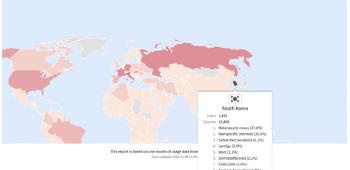High levels of phthalate exposure during pregnancy affect son genital development
May 23, 2025
|
At the first joint conference between the European Society of Pediatric Endocrinology (ESPE) and the European Society of Endocrinology (ESE), a research team from the Universities of Modena and Regio Emilia in Italy unveiled a study suggesting that environmental pollutants may change genital structure and affect future sexual development and reproductive ability.
Phthalates are artificial chemicals widely used in various consumer goods such as household detergents, food packaging, toys, cosmetics, and personal hygiene products.
They are classified as endocrine disruptors (EDCs), which can interfere with the body's natural hormonal function and have a detrimental effect on health.
In particular, boys exposed to phthalates during the fetal period are likely to suffer from genital defects, which may also lead to reduced reproductive capacity.
The distance between anus and genital organs (anus-gastroenteric distance, AGD) is utilized as a key indicator for assessing reproductive health and is associated with hormone levels, sperm quality, reproductive capacity, and related diseases.
The research team collected urine samples and anal-proliferative distance data from 188 newborns immediately after birth, at 3, 6, and 3 years, and their mothers also provided urine samples immediately after childbirth and when their children reached the age of 3.
The researchers analyzed eight major metabolites of phthalates and found that they were detected in all samples, and the amount of detection tended to increase over time. In particular, most children and mothers who participated in the study were exposed to higher levels of phthalates than the latest criteria.
Additionally, the researchers confirmed that the mother's phthalate exposure affects the development of genital organs in boys.
Studies have shown that 3-year-old boys born to mothers with high phthalate exposure had a shorter anal-proliferative distance.
The anus-proliferative distance of girls was affected by their own phthalate exposure, not by the parent's phthalate exposure, and the higher the exposure, the shorter the anus-proliferative distance.
Dr. Laura Lukacioni, who led the study, said "We were surprised that high levels of exposure were also identified even in phthalates, which are currently less regulated."In the context of continuous decline in baseline levels affecting hormones, daily exposure to these substances could pose a major health risk to future generations" he warned. He stressed that `public health measures are needed, especially to protect the vulnerable.'
Dr. Lucacioni said, `The eight phthalate metabolites analyzed in this study are included in everyday products such as toys, cosmetics, and soap"It is important to carefully check the raw materials of the products used and to come up with clear guidelines to minimize exposure" he added.
He then explained "For boys, prenatal and intra-family environmental exposures are likely to affect sexual development, and for girls, other mechanisms related to hormonal changes may be at play." The research team plans to continue tracking the effects of phthalate exposure on adolescent development through future research. Dr. Lukacioni stated "We intend to confirm the endocrine disrupting effect of phthalates through long-term observations and to determine their association with health problems such as adolescent disorders.".
This article was translated by Naver AI translator.














